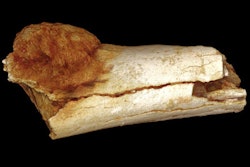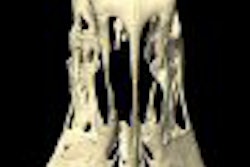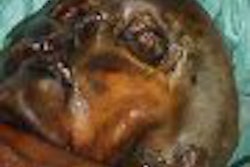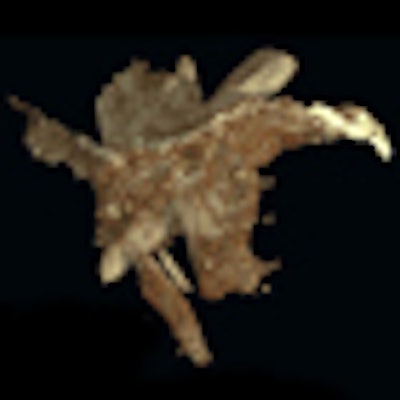
Anthropologists and archaeologists have discovered new evidence regarding the first humans and hunters in prehistoric North America, thanks to CT scans of the remains of a mastodon. The first-known hunters on the continent can now be dated back nearly 14,000 years, according to a recent study in the journal Science.
The mastodon remains were originally excavated at what is known as the Manis site in Washington state in 1977 by archaeologist Carl Gustafson. Since its discovery, what or who killed the mastodon has been a bit of a mystery. "The only documented artifact associated with the mastodon was a foreign osseous fragment, interpreted as the tip of a bone or antler projectile point," the study authors wrote (Science, October 21, 2011, Vol. 334:6054, pp. 351-353). But more than 30 years later, CT has offered some answers.
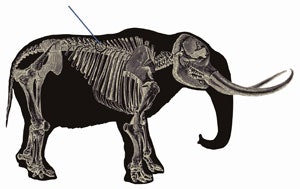 Approximate location and trajectory of projectile point. All images courtesy of Michael Waters, PhD, and the University of Copenhagen.
Approximate location and trajectory of projectile point. All images courtesy of Michael Waters, PhD, and the University of Copenhagen.Eske Willerslev, PhD, a professor of ancient DNA at the University of Copenhagen, and colleagues collaborated with a team led by Michael Waters, PhD, a professor of anthropology and geography at Texas A&M University, to re-examine the mastodon remains -- this time with CT and DNA analysis. Their findings help prove that the hunting in North America for large mammals such as the mastodon began almost 1,000 years earlier than previously thought.
Earliest hunters
The first evidence of hunting the mammoth-size mammal on the continent has been attributed to the Clovis culture, which is believed to have existed approximately 12,800 to 13,100 years ago and is so named for artifacts found near Clovis, NM. The Clovis people have been thought to be the first to enter the Americas and to be a common cultural ancestor for all Native Americans in North America. They settled on the continent after crossing the Bering Sea landmass from Asia as the last Ice Age ended.
"He discovered a remarkable artifact, and this was the tip end of a bone projectile point that was embedded in one of the ribs of the mastodon. And Gustafson got some radiocarbon dates from around the mastodon, and it dated 14,000 years ago. And, at the time, that was controversial, and the age was disputed, as well as the archeological evidence," stated Waters, the director of the Center for the Study of the First Americans and the executive director of the North Star Archaeological Research Program at A&M. "So, what we did is we proposed a new study on the important specimen -- the rib with the bone embedded in it" (Science, October 21, 2011, Vol. 334:6054, p. 395).
CT and new analysis
Waters and his team conducted "very precise bone dating" with radiocarbon dating using atomic accelerators and found "beyond a shadow of a doubt" that the specimen was 13,800 years old. They also scanned the rib with CT using 0.06-mm slices, revealing that the osseous object embedded in the rib is dense bone shaped to a point.
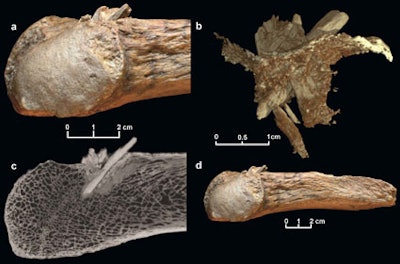 This figure shows a mastodon rib with the embedded bone projectile point. A: Close-up view. B: Reconstruction showing the bone point with the broken tip. The thin layer represents the exterior of the rib. C: CT image showing the long shaft of the point from the exterior to the interior of the rib. D: The entire rib fragment with the embedded bone projectile point.
This figure shows a mastodon rib with the embedded bone projectile point. A: Close-up view. B: Reconstruction showing the bone point with the broken tip. The thin layer represents the exterior of the rib. C: CT image showing the long shaft of the point from the exterior to the interior of the rib. D: The entire rib fragment with the embedded bone projectile point."The projectile point entered the dorsal surface of the proximal end of the rib immediately distal to the lateral margins of the two articular facets at approximately a 45° angle relative to the axis of the head of the rib. The point would have penetrated the hair and skin and about 25 to 30 cm of superficial epaxial muscles," the researchers wrote. "There is no evidence of bone growth around the point, indicating that the mastodon died soon after it was attacked."


The videos are made from CT scans that reveal a dense object made from bone embedded in the mastodon rib. The object is shaped to a point, which is penetrated 2.15 cm into the rib, after which it broke after entering the rib and separated from the main shaft. The combined length of the point fragment (tip length plus the length of the embedded and external shaft piece) is 3.5 cm. Above: CT images spliced together to form a video. Below: 3D animation of CT images of mastodon rib. Videos courtesy of Michael Waters, PhD, and the University of Copenhagen.


Willerslev and colleagues then analyzed the bone point using DNA and protein analysis, and discovered the arrowhead had been made out of mastodon bone. "So, that means that the people that are roaming around at 13,800 years ago were hunting other mastodons, or at least scavenging bone from these mastodons, and making bone artifacts, tools, and weapons, and then utilizing them to continue the hunting of other mastodons," Waters said. "This all just adds to the growing knowledge of pre-Clovis occupation of the Americas."
Earlier this year, Waters and colleagues reported their findings from an excavation site just north of Austin, TX (Science, March 25, 2011, Vol. 331: 6024, pp. 1599-1603). The team found more than 15,500 artifacts that date between about 13,200 and 15,500 years ago, confirming that humans occupied North America before the Clovis people.
And the mastodon findings are "further proof that humans have been present in North America for longer than previously believed," said Willerslev, director of the Centre for GeoGenetics at the Natural History Museum of Denmark. "The 'Clovis First' theory, which many scientists swore to just a few years back, has finally been buried with the conclusions of this study."
These latest findings also suggest humans may have played a role in the extinction of the megafauna, especially mammoths and mastodons, during the Pleistocene epoch (approximately 2.6 million to 12,000 years before present).
"There has been some evidence that showed that these megafaunal populations were in decline ... starting around 14,800 years ago, and probably a result of climate change and the vegetation shifts that were taking place, and these animals were under stress," Waters said. "But, also, we can clearly see now that there were some hunting pressures on these animals, because we have the Manis mastodon site and evidence that these people were hunting other mastodons ... all dating to the pre-Clovis time period. So, there were clearly hunting pressures on these animals earlier than we ever thought."





